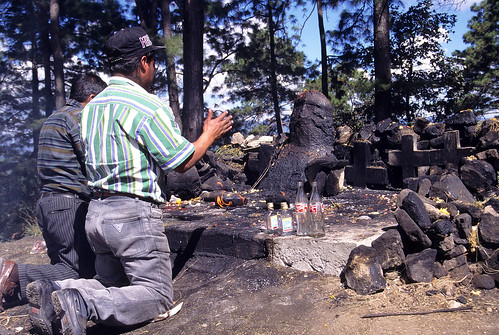 |
Accordingly, sacrifice is the core of Maya religion, as the key to exchanging "good." It is therefore no surprise that the rituals surrounding sacrifice are elaborate, since the gods themselves are constrained by the condition of conserved good, and require something before they give something else up; certainly they do not allow themselves to be sacrifices or scapegoats.
There are nineteen major deities (to say nothing of countless animistic spirits), connected with areas as disparate as rain, chocolate, corn, procreation, and thread; none by himself can do much without the involvement of another god, channeled through the labors of a shaman. Copal (resin incense), pulique (ceremonial meat), liquor, tobacco, firstfruits, periodic sexual abstinance, and live animals are among the forms sacrifice takes. Human sacrifice, pervasive in pre-Columbian times, has not been, nor could it be, renounced, even after five centuries of heavy suppression.
Some individual followers of Maya religion count the protection of spirit guides, which provide luck and tutelage. For this reason, the observation of a fish, bird, or quadruped in an unusual circumstance can be an augury, signaling that the spirit guide has "touched base" and that change or blessing is imminent. As in many North Ameican tradtions, the coyote is the most desirable spirit guide, for the wisdom and luck he purports.
The syncretism of Catholicism and Maya religion (notably the sophisticated Custom of the Tzutijiles centered on Santiago Atitlan) is arguably not an equal mixture, but rather Maya religion with a Catholic veneer. Mayan deities have commandeered counterparts in the saints, virgins, and even multiple "Christs". The celebrated deity/effigy Maximon, for instance, incorporates multiple identities, which vary from town to town, depending on the town's character and needs. Most Maximons are subjected to symbolic sacrifice by "hanging", but Santiago's renowned Maximon (a mix of Jesus, Simon the Zealot, and Judas Iscariot), is consistently revered and brings blessing to households that host him for a year (by bringing paying pilgrims and tourists).
Admittedly, some Mayas are orthodox Catholics, and others observe "pure" Maya catechism. But Maya religion, and its co-optation of imported European tradition, remained unchallenged until the second half of the 20th century, when the juggernaut of evangelico reformation in Latin America began displacing it, such that today Guatemala is a Protestant country where the concept of conserved good, and therefore Maya religion itself, are eschewed by new believers unwilling to brook syncretism. Nevertheless, Maya religion retains a huge legacy, having been the primary ethos and shaper of Guatemala, the Western Hemisphere's oldest country, until the most recent era.
Dwight Wayne Coop
Staff Writer.
See also: